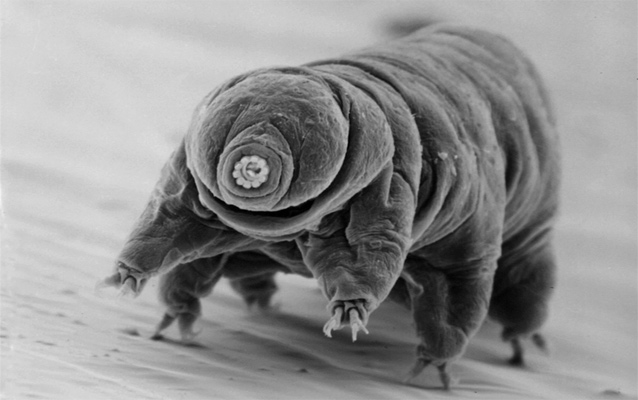DNA Analysis Reveals Why 'Water Bears' Are the World's Toughest Animals

Tardigrades, also known as water bears, are less than a fraction of an inch in length, yet they are believed to be Earth's toughest, hardiest animals. They are virtually indestructible. Tardigrades have the ability to withstand complete dehydration. Once desiccated, they have been frozen in blocks of ice, exposed to radiation, and sent into the vacuum of space, and yet they still usually spring back to life when water becomes available again.
New genetic research, published in the journal PLOS Biology, reveals how tardigrades achieve such resurrections after drying to a crisp. The authors now even believe that alien life forms could possess this remarkable ability.
"If life exists on other planets, and it is water-based, then those organisms that live out of water will evolve to resist extreme events, including the threat of drying out," said co-author Mark Blaxter of the University of Edinburgh's Institute of Evolutionary Biology.
He added that the ability to undergo anhydrobiosis — the desiccated, dormant state — "has evolved multiple times on Earth, so I am sure it will have evolved on other living planets."
Blaxter and his colleagues took a clever approach to unravel the scientific secrets behind anhydrobiosis in tardigrades.
The scientists re-sequenced and reassembled the genome of Hypsibius dujardini, a tardigrade that can only undergo desiccation after extensive pre-exposure to drying conditions. They then compared the tiny animal's DNA with that of Ramazzottius varieornatus, a related species with tolerance to rapid desiccation.
The researchers then looked at a particular set of genes, the so-called HOX genes, which establish the nose-to-tail pattern in embryos. There are usually about ten different HOX genes in animals, but tardigrades are missing five. Nematodes (roundworms) lack these same five genes.
Sign up for the Live Science daily newsletter now
Get the world’s most fascinating discoveries delivered straight to your inbox.
RELATED: Microscopic Tardigrade 'Water Bears' Will Be the Last Survivors on Earth
"This could be because they share a common ancestor with tardigrades, and the loss happened in this ancestor," Blaxter said. "Alternatively, it could be that the loss is associated with both groups becoming miniaturized, and these 'middle' HOX genes are the ones that are the easiest to lose."
He added that the shared genetic loss could also simply be due to independent evolution. Because of these remaining questions, scientists continue to debate whether or not tardigrades are more closely related to nematodes or to arthropods — insects, spiders, and crustaceans.
By asking which genes were turned on during tardigrade anhydrobiosis, the scientists could identify sets of proteins, which appear to replace the water that tardigrade cells lose, thus helping to preserve the microscopic structures until water is available again.
Arakawa explained that all cells contain around 60–80 percent water when they are active, including human cells.
The key proteins that they identified are highly soluble. They dissolve in water that, due to surface tension, clings to and surrounds intracellular molecules within tardigrades. Like a microscopic protective coating, they prevent the cells from denaturing when the animal otherwise desiccates.
Arakawa added that tardigrades also possess additional genes that protect their DNA from damage. Because these small animals lack stress-sensing pathways, their cells do not usually die out when damaged. Instead, the identified proteins try to make repairs, and are often successful in doing so.
Due to these abilities, scientific consensus holds that tardigrades could be Earth's last survivors. Such resilience is unexpected in a tiny creature that seems to exist in the slow lane.
"Tardigrades are slow walkers, and are not really aggressive animals," Arakawa explained. "Therefore, they tend to lose competitions for food, or can become prey in a diversified ecosystem. But tardigrades fled to their own niche, where only tardigrades can survive, so paradoxically, tardigrades presumably acquired their extreme survival abilities due to their ecological incompetence."
RELATED: Tardigrade 'Water Bear' Dries to a Crisp and Then Comes Back to Life
Arakawa and his colleagues can envision a day when enzymes, vaccines, human organs, tissues, and cells could be preserved in a state of anhydrobiosis instead of by liquid-nitrogen-based freezing.
"Some people have suggested that tardigrades could somehow travel through space to seed other planets with Earth-derived life," Baxter said. "That obviously didn't happen on Earth, as only some tardigrades are able to do anhydrobiosis, and tardigrades are derived from other, more ancient forms."
While it is doubtful that tardigrades are somehow hurtling through space now, these amazing animals continue to captivate researchers. Blaxter and Arakawa, for example, have been studying them with awe and admiration for years.
Blaxter, one of the few tardigrade genomics experts in the world, reminisced that his scientific career was sewn when, as a child, he was gifted with an animal encyclopedia by his parents.
"I especially pored over the weird and wonderful animals that were so beyond what I had seen with my own eyes," he recalled.
When, many years later, one of his Ph.D. students suggested that he study tardigrades, a lightbulb went off.
"We haven't looked back," Blaxter said.
Originally published on Seeker.









